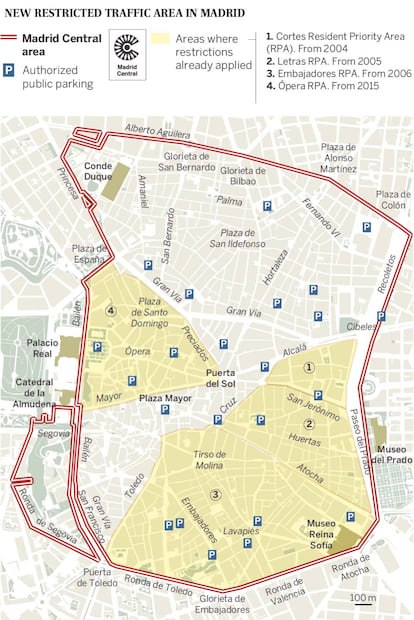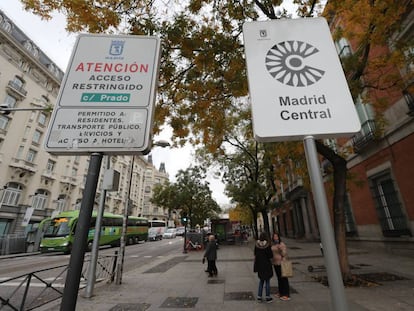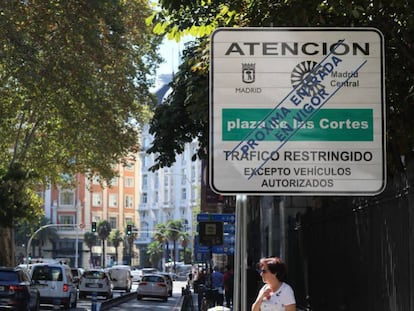Madrid City Hall bans older, more polluting cars from center
Vehicles with no environmental sticker will also be prohibited from using the M-30 ring road. The regional government will not be boosting train or Metro services

The city of Madrid has activated new traffic restrictions aimed at reducing the current high levels of air pollution in the Spanish capital.
Police checks are in place to prevent vehicles without the right environmental sticker from entering the city center
Starting on Wednesday, the older, most polluting vehicles are not being allowed within the perimeter of the M-30 ring road or on the beltway itself. Additionally, the speed limit on the M-30 has been set at 70 kilometers per hour.
Police checks are in place to prevent vehicles without the right environmental sticker from entering the city center, where further regulations apply as part of a new mobility plan from City Hall called Madrid Central, which covers 472 hectares and introduces a raft of new restrictions. Cameras will also monitor license plates of vehicles that enter the area.

Environmental stickers are issued by the Spanish traffic authority DGT, and the ones allowing access to central Madrid are those classified as 0 (i.e. electric cars with zero emissions), ECO (hybrid vehicles), C and B (modern diesel and gasoline vehicles). Older vehicles – those manufactured prior to the year 2000 in the case of gasoline and 2006 for diesel – are not eligible for such stickers, meaning they are permanently precluded from entering the Madrid Central area.
Demand for environmental stickers
The activation of today’s pollution protocol saw huge lines in Correos post offices this week, as Madrileños sought to get hold of environmental stickers for their vehicles – despite the fact that they will not be obligatory until next year.
Sources from Correos told the Europa Press news agency that citizens have turned out “en masse” to get hold of the stickers, creating a “huge workload” for staff.
Some drivers reported having had to wait for at least two hours before they were served, while others left empty handed after post office branches ran out of stickers.
Correos said on Tuesday that it has already sold 380,390 throughout the Madrid region.
City officials explained that for now there will be no fines for not having the sticker, as these will not be mandatory until April 24, 2019, but they do recommend getting them as soon as possible (they are available at Correos post offices for €5 upon presentation of the vehicle’s documentation).
Only cars with the 0 and Eco stickers will be able to park in regulated parking spaces on Madrid’s streets today (the green and blue zones), with the exception of residents, the disabled and authorized commercial and industrial vehicles.
The DGT says that the measure is aimed at “positive discrimination of the most environmentally friendly vehicles and to become an efficient tool of municipal policies.”
The traffic authority also notes that the sticker is currently voluntary, but “since it makes it easy to quickly identify the less-polluting vehicles, it is recommended to place it in the bottom right of your car’s windscreen.”
The DGT website offers the possibility of checking a vehicle’s category through its license plate number.
Traffic problems
At 7.30am on Wednesday, there were inbound traffic jams throughout the south of the city, as well as on the A-4, A-2 and A-6 roads, with fog complicating transport.
The municipal transportation authority EMT has rolled out additional buses on 55 lines, but the underground Metro system, which is managed by the Regional Transportation Consortium, has not increased the frequency of its trains, arguing that a similar restriction on December 28 of last year only saw passenger numbers rise by 0.86%. The subway system is also experiencing a series of stoppages by drivers over work conditions.
As for the Cercanías commuter train system, also controlled by the regional government, there will be no extra services today on top of those already in place due to the Christmas season.
The environmental department of Madrid City Hall decided on Wednesday to deactivate the restrictions on Thursday, given that the levels of pollution in the center are falling and weather conditions are improving to help clean the air. Rain is forecast for tonight, which will also help improve the situation. If the level of pollution had increased, vehicles ineligible for an environmental sticker would have been banned from driving in the entire city.
A historic step to becoming a car-free city center
The Madrid Central system was launched on November 30, bringing the Spanish capital in line with a global list of pioneering cities fighting air pollution through local initiatives. The project is part of a larger move to improve the quality and safety of a space that is shared by cars, motorcycles, pedestrians, bicycles and a growing number of personal mobility devices.
Viewed as a legacy-making project for Mayor Manuela Carmena, of the leftist Ahora Madrid party, Madrid Central has made 472 hectares of the city center off-limits to traffic, except for local residents and public transportation. Non-residents with appropriate environmental labels may enter to leave their vehicle in a public parking lot, and exceptions are made for people with reduced mobility, ambulances, taxis, private-hire cars and delivery vans. Electric vehicles will also be allowed into Madrid Centro.
Improving the air quality in cities is a EU mandate, and the European Commission has set 2020 as the deadline for Madrid to meet its targets. City officials say that Madrid Central will reduce emissions by 40% as a result of eliminating through traffic and banning the biggest polluters from the area.
English version by Susana Urra and Simon Hunter.
Tu suscripción se está usando en otro dispositivo
¿Quieres añadir otro usuario a tu suscripción?
Si continúas leyendo en este dispositivo, no se podrá leer en el otro.
FlechaTu suscripción se está usando en otro dispositivo y solo puedes acceder a EL PAÍS desde un dispositivo a la vez.
Si quieres compartir tu cuenta, cambia tu suscripción a la modalidad Premium, así podrás añadir otro usuario. Cada uno accederá con su propia cuenta de email, lo que os permitirá personalizar vuestra experiencia en EL PAÍS.
¿Tienes una suscripción de empresa? Accede aquí para contratar más cuentas.
En el caso de no saber quién está usando tu cuenta, te recomendamos cambiar tu contraseña aquí.
Si decides continuar compartiendo tu cuenta, este mensaje se mostrará en tu dispositivo y en el de la otra persona que está usando tu cuenta de forma indefinida, afectando a tu experiencia de lectura. Puedes consultar aquí los términos y condiciones de la suscripción digital.
More information
Archived In
Últimas noticias
Most viewed
- Sinaloa Cartel war is taking its toll on Los Chapitos
- Oona Chaplin: ‘I told James Cameron that I was living in a treehouse and starting a permaculture project with a friend’
- Reinhard Genzel, Nobel laureate in physics: ‘One-minute videos will never give you the truth’
- Why the price of coffee has skyrocketed: from Brazilian plantations to specialty coffee houses
- Silver prices are going crazy: This is what’s fueling the rally










































